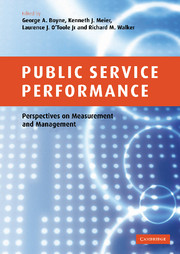Book contents
- Frontmatter
- Contents
- List of figures
- List of tables
- Notes on contributors
- 1 Introduction
- 2 Subjective and objective measures of organizational performance: An empirical exploration
- 3 All measures of performance are subjective: More evidence on US federal agencies
- 4 A qualitative evaluation of public sector organizations: Assessing organizational performance in healthcare
- 5 Quantitative approaches towards assessing organizational performance
- 6 Consequences of goal ambiguity in public organizations
- 7 Performance control and public organizations
- 8 Bureaucratic red tape and organizational performance: Testing the moderating role of culture and political support
- 9 All that glitters is not gold: Disaggregating networks and the impact on performance
- 10 Network evolution and performance under public contracting for mental health services
- 11 The design and management of performance-based contracts for public welfare services
- 12 Outsourcing government information technology services: An Australian case study
- 13 International comparisons of output and productivity in public service provision: A review
- 14 Public management and government performance: An international review
- 15 What drives global e-government? An exploratory assessment of existing e-government performance measures
- 16 Public management and organizational performance: An agenda for research
- Index
- References
7 - Performance control and public organizations
Published online by Cambridge University Press: 22 September 2009
- Frontmatter
- Contents
- List of figures
- List of tables
- Notes on contributors
- 1 Introduction
- 2 Subjective and objective measures of organizational performance: An empirical exploration
- 3 All measures of performance are subjective: More evidence on US federal agencies
- 4 A qualitative evaluation of public sector organizations: Assessing organizational performance in healthcare
- 5 Quantitative approaches towards assessing organizational performance
- 6 Consequences of goal ambiguity in public organizations
- 7 Performance control and public organizations
- 8 Bureaucratic red tape and organizational performance: Testing the moderating role of culture and political support
- 9 All that glitters is not gold: Disaggregating networks and the impact on performance
- 10 Network evolution and performance under public contracting for mental health services
- 11 The design and management of performance-based contracts for public welfare services
- 12 Outsourcing government information technology services: An Australian case study
- 13 International comparisons of output and productivity in public service provision: A review
- 14 Public management and government performance: An international review
- 15 What drives global e-government? An exploratory assessment of existing e-government performance measures
- 16 Public management and organizational performance: An agenda for research
- Index
- References
Summary
Introduction
This chapter is designed to contribute to the discussion on determining the performance of public organizations by investigating the relationship between performance control systems and performance. It cannot be assumed that performance control systems automatically lead to performance. Neither shall we assume that management control systems are the same as performance control. To do so would be a case of ‘managementism’ which has been described by Dubnick (2003: 9) as a phenomenon where ‘management is seen as the premium mobile that shapes and drives the basic logic of the common research agenda for contemporary Public Administration’. Consequently, we will demonstrate that different forms of performance control do exist. Which form is the most likely to contribute to performance depends on a number of conditions.
In this chapter, we first give a definition of control systems; second, present different types of performance control systems; and third, formulate propositions about how different control approaches contribute to organizational performance. In the last part we discuss the limitations and the opportunities from these insights in providing a solid basis for improving the performance of public organizations.
The definition of performance control and types of performance control
Performance control is defined here as ‘the process of monitoring performance, comparing it with some standards, and then providing rewards and adjustments’ (see Ouchi 1977: 97). This definition should not be misinterpreted, as has often been done, by equating it with performance management, management control systems, management accounting systems, organizational control and management control (Ashworth et al. 2002).
- Type
- Chapter
- Information
- Public Service PerformancePerspectives on Measurement and Management, pp. 113 - 129Publisher: Cambridge University PressPrint publication year: 2006
References
- 5
- Cited by

